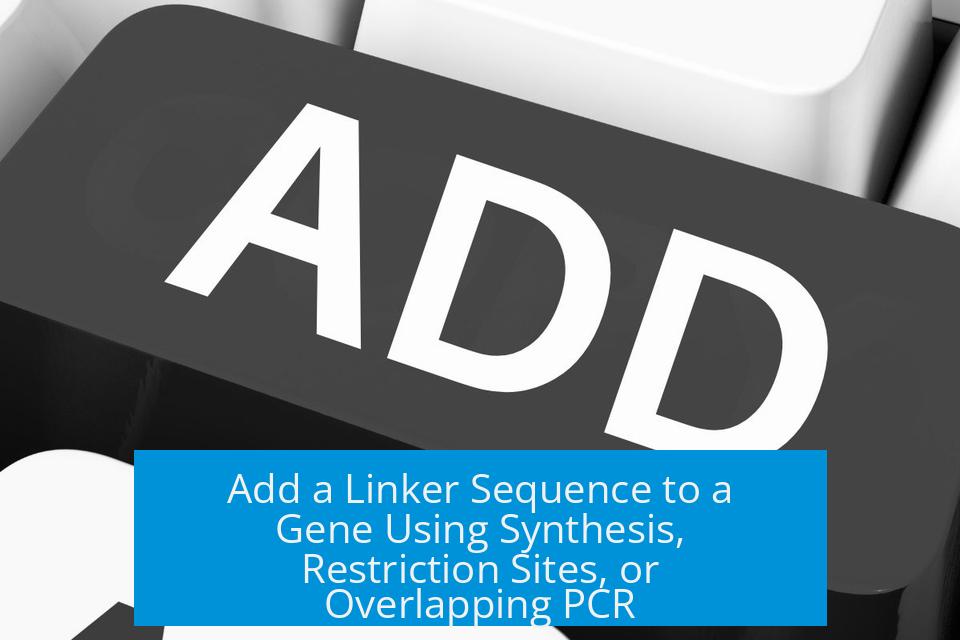How to Add a Linker Sequence to a Gene
Adding a linker sequence to a gene typically involves either including the linker during gene synthesis or incorporating it through molecular cloning techniques such as overlapping PCR. The linker may serve as a peptide spacer for fusion proteins or as a DNA segment containing restriction sites for cloning. Best practice often depends on the intended application—protein fusion or gene cloning—and available resources.
Understanding the Purpose of a Linker Sequence
Before proceeding, it is essential to clarify what the linker represents in your experiment. A linker can be:
- A short peptide sequence placed between two protein domains to enable flexible or stable fusion, preventing steric hindrance.
- A DNA sequence containing restriction enzyme recognition sites used to clone a gene into a vector.
Determining the linker’s role guides the design strategy. If the goal is to generate a fusion or hybrid protein, peptide linkers are required at the amino acid level. If the goal is molecular cloning, adding restriction sites upstream or downstream of the gene in the DNA sequence serves as the linker.
Method 1: Include Linker in Gene Synthesis
Ordering a synthesized gene is one of the simplest ways to incorporate linkers. When submitting a gene synthesis order (for example, from commercial providers), you can provide the full nucleotide sequence that includes the linker:
- Design the gene including the peptide linker coding sequence.
- Include restriction enzyme sites needed for cloning at either or both ends.
- Submit the composite sequence with linkers directly for synthesis.
This approach reduces cloning steps and minimizes errors related to linker incorporation. Providers offer custom gene synthesis services (e.g., gBlocks or entire gene fragments) where you specify the entire desired construct.
As a practical example, if you want to fuse a gene of interest with a reporter gene, you can order the gene sequence containing the linker coding part plus restriction sites to facilitate cloning into your plasmid vector.
Method 2: Utilize Restriction Sites as Linkers
Often, restriction enzyme recognition sequences upstream or downstream of your gene serve dual roles:
- They act as molecular handles to cut and ligate DNA fragments during cloning.
- The non-coding sequence adjacent to these sites can function as a minimal linker region.
When designing primers for PCR amplification, you can incorporate restriction sites into the 5′ ends. This practice creates a natural linker segment between your gene and the cloning vector:
- Typically, restriction sites are positioned just before the start codon or after the stop codon.
- This spacing can provide sufficient length and flexibility as a linker sequence for fusion proteins or simple cloning.
Adding the correct restriction sites or linkers via primers is efficient when synthesizing genes from PCR products instead of ordering the full sequence.
Method 3: Add Linkers via Overlapping PCR
If direct gene synthesis is not an option or additional flexibility is required, overlapping PCR is a powerful method to add linker sequences:
- Design primers that contain linker sequences at their 5′ ends.
- Amplify both genes (e.g., gene of interest and reporter gene) separately using primers that add overlapping linkers.
- Mix the PCR products without external primers for several cycles to allow the overlapping linker regions to anneal and extend, creating a fused DNA molecule.
- Perform a final PCR with primers flanking the fused product to amplify the chimeric gene.
This method allows precise control over linker composition and length. Linkers typically encode flexible peptide sequences (like glycine-serine repeats) to maintain protein function after fusion.
An example workflow is as follows:
- Add linker sequence to the 3′ end of the first gene via primers.
- Add a complementary linker sequence to the 5′ end of the second gene.
- Perform initial PCRs on each gene separately to add these linkers.
- Combine PCR products without primers for 7–10 cycles to allow overlap extension.
- Amplify the fused gene with external primers.
Key Considerations When Adding Linkers
- Restriction Sites: Always include restriction enzyme sites if the fusion gene needs to be cloned into plasmids.
- Reading Frame: Ensure the linker and fusion genes are in the correct reading frame to prevent frameshifts that disrupt protein sequence.
- Linker Length and Composition: Choose appropriate linker sequences depending on the flexibility and spacing required between fused proteins.
- Compatibility: Verify that linker sequences do not introduce unwanted restriction sites or secondary structures that impede cloning or expression.
- Primer Design: When using overlapping PCR, primers must be carefully designed to include linker and target gene sequences seamlessly.
Advantages of Each Method
| Method | Pros | Cons |
|---|---|---|
| Gene Synthesis with Linker |
|
|
| Restriction Sites as Linkers |
|
|
| Overlapping PCR |
|
|
Summary
- Include linker sequences and necessary restriction sites when ordering gene synthesis to streamline cloning and fusion.
- Restriction sites upstream of a gene can function as linker sequences for cloning into plasmids.
- Clarify if the linker is a peptide sequence for protein fusion or just a cloning tool to tailor design approach.
- Use overlapping PCR to generate fusion genes with custom linkers when gene synthesis is not preferred or unavailable.
- Ensure accurate reading frames and primer design to prevent artifacts and enable successful expression.
How can I include a linker sequence when ordering a synthesized gene?
Simply add the linker sequence to the gene sequence in your synthesis request. The supplier will provide the gene with the linker included, ready for cloning.
Can restriction sites act as linker sequences for cloning?
Yes. Restriction sites placed upstream of the gene can serve as linker sequences. You can design primers to include these sites, combining linker and cloning functions.
What is the difference between a peptide linker and cloning linkers?
A peptide linker connects two proteins in a fusion, while cloning linkers usually refer to restriction sites needed to insert the gene into a plasmid.
How does overlapping PCR add a linker sequence to a gene?
Primers with linker sequences are used to amplify genes. Two gene fragments with complementary linker regions are mixed without primers for initial cycles, allowing them to hybridize. This forms a fused gene for further PCR amplification.
Is it necessary to include restriction sites when adding linkers for fusion proteins?
Yes. If you plan to clone the fused gene into a plasmid, include restriction sites in the linker regions or primers to facilitate the cloning process.





Leave a Comment